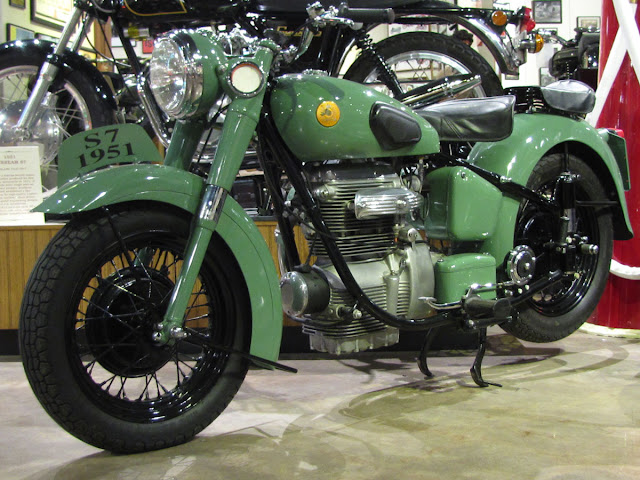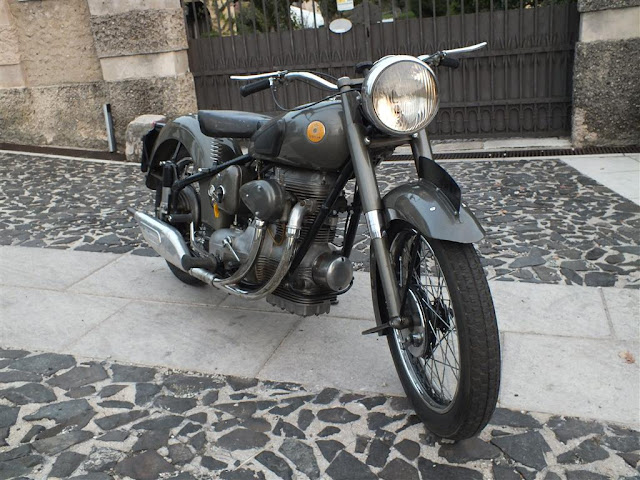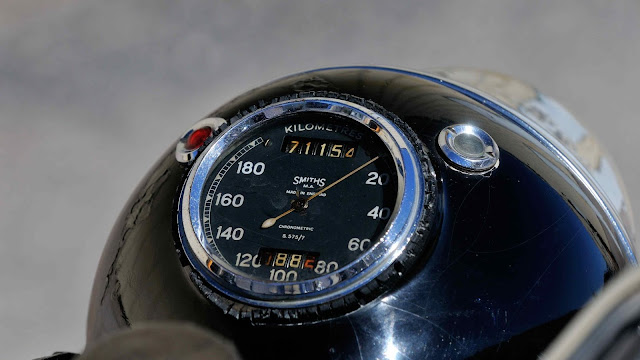Sunbeam S8
The S8’s handling was an improvement on that of the S7, due to reduced weight, new front forks plus narrower wheels and tyres.
Despite its unusual tandem twin engine layout, the S8’s styling, black paint finish and chassis design were conventional, in contrast to its heavier and more eye-catching S7 predecessor.
With its smooth and reliable 487cc twin- cylinder engine, good handling and a reasonable turn of speed, the S8 was the finest bike that the famous Sunbeam marque, whose history of motorcycle production stretched back to 1912, had ever built. The S8, introduced in 1949, was essentially a sportier and more reliable version of the S7, which had sold poorly following its release two years earlier.
The basic layout of the S8’s engine was identical to that of the S7. Sunbeam’s tandem twin unit had a 360-degree crankshaft and shaft final drive. It was also unusual in having a chain-driven single overhead camshaft, instead of the more common pushrods. Numerous changes, most of them made in a bid to cure the S7’s unreliability, included extra oil capacity and redesigned pistons. The S8 was also more powerful than the original model. Its increased compression ratio and less restrictive exhaust pipe increased peak output slightly to a claimed 26bhp at 5800rpm.
Traditional black
Paint finish was black, Sunbeam's traditional choice in the days when the Wolverhampton marque was highly regarded for its top quality construction. The S8 retained the S7’s twin- downtube steel frame and gained a significant handling improvement with new front forks, as well as narrower wheels and tyres. The forks were conventional BSA telescopies, in place of the original twin’s unsuccessful design, which had a single spring between the legs and no hydraulic damping at all. Rear suspension was by plunger, as before, backed up by a sprung single saddle.
The S8’s top speed was just over 80mph (129km/h), about 5mph (8km/h) up on the S7, but it was on acceleration that the lighter bike had a bigger advantage. Its standing quarter-mile time of 18 seconds was several seconds quicker than the heavier S7 could manage, and the new bike generally had a much more lively feel. The S8’s revised rubber-mounting system was very effective, almost completely isolating the traditional parallel- twin shakes. But the positive comments could not be extended to the S8’s front brake, a single- leading-shoe drum that was rated as mediocre in contemporary tests.
Smooth and reliable
In most respects, though, the S8 was highly regarded, and it was certainly a more impressive machine than the S7. It was easy to start, smooth. reliable and comfortable, once leaving Motor Cycling magazine’s tester feeling reasonably fresh after covering over 500 miles (805km) in 24 hours - quite an achievement in the 1950s. The S8 was also more competitively priced than its predecessor, and accounted for the majority of the 10,000 Sunbeam twin sales during the four years to 1952. But from then on development of the S8 was minimal and, after BSA and Triumph had merged in late 1956, Sunbeam production was stopped.
The S7 - Sunbeam's First Tandem Twin
Sunbeam's problems stemmed from the unsuccessful introduction, ten years earlier, of the S7 model on which the S8 was based. The distinctive S7, whose similar twin-cylinder engine was dwarfed by American-style parts including balloon tyres and big, skirted fenders, was intended as a luxurious and refined roadster. It was advertised as 'the world's most magnificent motor cycle', and was certainly one of the most expensive.
When running well, the S7 was a comfortable and agreeable tourer, but it suffered from a number of basic design flaws. For a 500cc twin it was rather heavy and not very fast. It handled poorly, due partly to its huge tyres, and had feeble brakes. Its shaft-drive motor was not particularly economical, and also developed a reputation for unreliability, with problems including overheating, cracked cylinder liners and main bearing failure. Inevitably, few were sold. And despite the arrival of the S8, Sunbeam's fortunes never recovered.
The S8’s 487cc tandem twin engine was closely based on that of the S7, but incorporated modifications including new pistons and increased oil capacity, which made it more reliable. A new exhaust system helped increase output, to 26bhp.
Specification Sunbeam S8 (1949)
- Engine Air-cooled sohc four-valve tandem twin
- Capacity 487cc (70 x 63.5mm)
- Maximum power 26bhp @ 5800rpm
- Transmission Four-speed, shaft final drive
- Frame Steel twin downtube
- Suspension Telescopic front; plunger rear
- Brakes Drum front and rear
- Weight 400lb (181kg)
- Top speed 80mph (129km/h)




















0 comments: